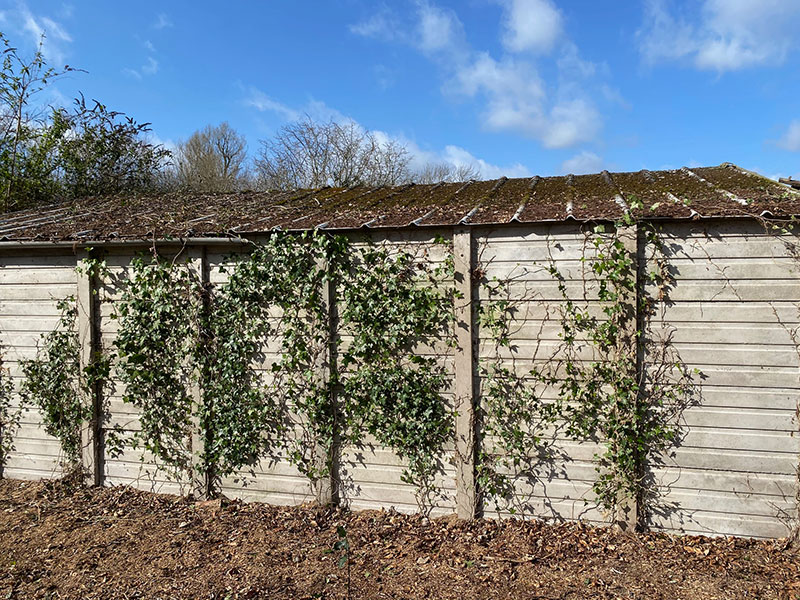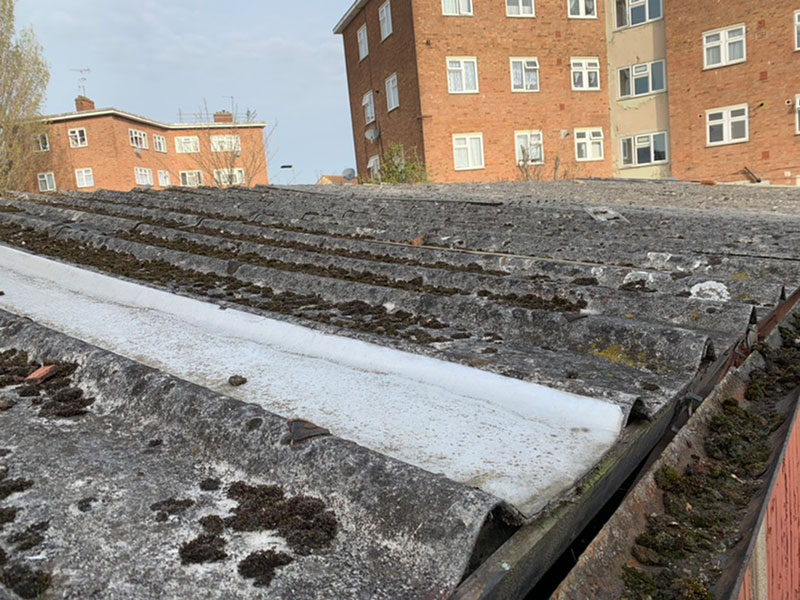Asbestos removal from garages and sheds: What are the do's and don'ts?
While the UK banned the use of asbestos in 1999, structures built before that are still likely to include asbestos-containing materials (ACMs). While an ACM in good condition doesn’t pose an immediate threat, deteriorating or damaged ACMs must be removed.
Damaged asbestos releases fibres that can be inhaled and permanently adhere to the lungs. This can cause life-threatening illnesses anywhere from 10 to 40 years down the road, including various types of cancer.
Identifying ACMs, determining if they pose a threat and coming up with a plan of action for removal are imperative to keeping you and everyone in or around the building safe.

Identifying asbestos in garages and sheds
Since the use of asbestos was so prevalent, it can be difficult to know exactly where ACMs are present. This is why you should have a professional asbestos survey and testing carried out.
Cement is a common material used in garages and sheds, and cement panels are likely to contain asbestos. The material was commonly used to reinforce parts of a structure that are exposed to the elements because asbestos is resistant to harsh environmental conditions.
It’s also common for asbestos to be found in garage roofing. If the roof is made of a grey corrugated material, assume it contains asbestos. If another material is used for the roofing, like corrugated iron or reinforced plastic, it isn’t likely to contain asbestos.
When it comes to materials you’re unsure of, though, a good rule of thumb is to assume they contain asbestos until you can confirm they don’t. That way, you won’t accidentally disturb the asbestos should it exist.
Suspecting asbestos in your garage or shed: What to do
Once you suspect that your garage or shed may contain asbestos, avoid using power tools like drills and sanders. Performing this type of work on the building can damage ACMs and release asbestos fibres into the air.
Also, let anyone on the premises know that asbestos is present and the areas to stay away from.
When work begins on the asbestos removal project, only those who are directly involved with the removal and wearing the proper protective equipment should be in the work area. Also, any areas that could be affected by airborne asbestos fibres should be sectioned off.
To reiterate, don’t allow animals, children or anyone else in an area where damaged asbestos is present.
Next, seek the advice of a professional asbestos removal contractor. They will advise you on how to keep everyone safe and the next steps to take to properly remove the ACMs.
The do’s of asbestos removal from a garage or shed
Do develop a safe removal plan
Prior to removing ACMs from your garage or shed, you’ll need to conduct an asbestos risk assessment and develop a safe removal plan. That includes:
- Collecting tools to remove asbestos panels and other ACMs, such as an adjustable spanner wrench, a claw hammer, a hacksaw, ladders and a large screwdriver.
- Working on asbestos roofing without actually going on the roof. Asbestos cement can be brittle, and attempting to stand on the roof could put you at risk of falling through. Not only would that cause you bodily harm, but asbestos fibres could be released when the cement gets further damaged.
- Finding waste sites that accept the types of asbestos materials you’re disposing of and coordinating a time for drop-off.
Do wear the proper protective gear
It’s imperative that you wear the proper personal protective equipment (PPE) and respiratory protective equipment (RPE) when working with ACMs. That includes the following:
Disposable clothing, like paper overalls or old clothing that you can throw away when you’re done. It’s difficult to clean clothing that’s been exposed to asbestos fibres without contaminating the washer and dryer, as well as other clothing that ends up being cleaned in them.
Masks that fit correctly over your nose and mouth with no gaps. Disposable fibre masks can be purchased online. They should be made to EU standards EN149 or EN1827 for the most protection possible.
When disposing of PPE or RPE, everything must be double-wrapped in heavy-duty bags and sealed, the same way that you dispose of other types of asbestos waste.
The Health and Safety Executive goes into more detail about PPE and RPE here.
Do follow health and safety guidelines during the removal process
There are a number of health and safety guidelines to follow when working with asbestos. Those include:
- Not eating, drinking or smoking when working with or around asbestos.
- Keeping asbestos cement wet to minimise the release of asbestos fibres into the air. That means you’ll need a hosepipe or water spray gun on hand. Only low-pressure water should be used to avoid fibre release.
- Wrapping garage panels and roofing sheets in plastic sheeting.
- Double-wrapping smaller pieces of asbestos debris in heavy-duty plastic bags and labelling them clearly.
Do hire a professional
While you’re not always legally obligated to hire an asbestos specialist for removal, it’s usually the safest option.
Removal requires advanced knowledge of ACMs, asbestos types and removal procedures, as well as the proper equipment. Unless you’re well-equipped with all of those must-haves, you can’t be sure that you’re taking the proper measures to keep everyone safe before, during and after removal.
If you have any concerns about your competency with removing asbestos, err on the safe side and hire a licensed asbestos removal contractor.
Do make sure the team has the proper training
When searching for an asbestos removal contractor, inquire about their asbestos training. Not only should they have taken asbestos awareness within the past 12 months, but they should also be UKATA certified.
The don’ts of asbestos removal from a garage or shed
Don’t use power tools or abrasive removal methods
While certain types of tools are required when removing ACMs from a garage or shed, professionals know the correct methods to get rid of asbestos without causing the unnecessary release of asbestos fibres.
For example, wetting ACMs prior to working on them can limit how many fibres are released into the air during removal.
You also don’t want to break up large ACMs for easier disposal because damaging them can cause a worse asbestos exposure situation than already exists.
Don’t cause an unnecessary disturbance to asbestos materials
Even slight damage to ACMs can cause dangerous fibre release. Never move, damage or otherwise disturb ACMs. Even surrounding debris could have asbestos fibres in it, so everything in the garage or shed should remain undisturbed until a removal team can take over.
Don’t try to remove asbestos on your own
The risks of exposure during DIY asbestos removal are too high to make it worth it. You should always hire a professional contractor who’s skilled at removing asbestos and has the proper equipment and training to carry out the job.
Cost of asbestos removal and consideration of alternatives
The cost of removing asbestos from a garage or shed depends on the scale of the work. For example, when dealing with a garage roof, you have to consider specifics like:
- The size and pitch of the roof
- How accessible the roof is
- Gutters, pipes and other ACMs
We have an article that covers the average cost of removing asbestos from a roof, but having a survey conducted is the best way to get a reliable price quote.
It’s smart to get quotes from a few different licensed contractors to compare costs. However, don’t automatically go with the least expensive option. Asbestos removal is a highly specialised field, and a contractor who charges far below the industry standard should be a red flag.
Also, keep in mind that removal isn’t always the safest option when it comes to ACMs. If the ACM is still in good condition and hasn’t been damaged, it may be safer to leave it where it is. Sometimes, encapsulation or enclosure are better alternatives to removal, at least for now.
Safe asbestos encapsulation and management
Encapsulation and enclosure aren’t permanent solutions when you have damaged ACMs. While these methods can reduce the risk of asbestos exposure temporarily, the ACMs should eventually be removed by a professional.
Regular monitoring of all ACMs is necessary, whether the material has been encapsulated or it’s been in good condition. Property owners must know how to manage asbestos on an ongoing basis so that nobody ends up at risk.
Final thoughts
Asbestos removal from garages and sheds should always be handled by a professional. From the moment asbestos is discovered, the proper safety precautions should be followed.
Building occupants, workers and visitors have the right to a safe environment. Responsible asbestos management is the only way to keep everyone protected.
Contact us today if you need help removing asbestos from your property.

Written by Callum McDonald
Callum McDonald is an expert in asbestos quality management, ensuring rigorous adherence to regulations and high-quality standards in removal projects. His focus on enhancing quality and client satisfaction makes him a crucial asset in safety and compliance within the field. Callum's expertise in technical support and oversight of licensed works underscores his commitment to excellence in asbestos management, providing invaluable guidance to clients in this specialised area.

